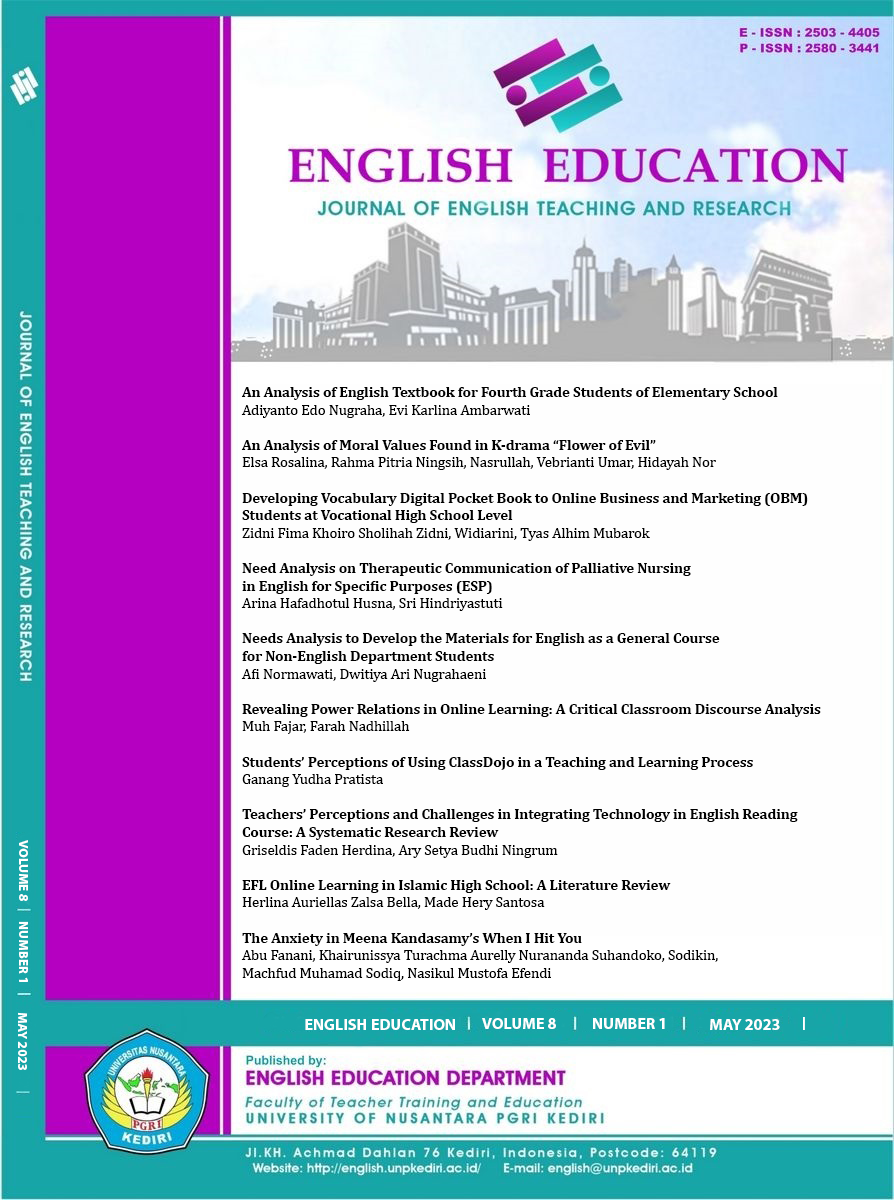Developing Vocabulary Digital Pocket Book to Online Business and Marketing (OBM) Students at Vocational High School Level
DOI:
https://doi.org/10.29407/jetar.v8i1.18755Keywords:
Digital vocabulary pocket book (DVPB);, English vocabulary;, Mastering vocabulary;, Online Business and Marketing(OBM)Abstract
This research is based on an analysis of vocational high school students’ needs majoring in Online Business and Marketing (OBM). It was found that the students faced difficulties in mastering vocabulary, in which vocabulary is a fundamental and important component for communication. Ideally the vocabulary that should be mastered is related to their major study. In order to overcome this problem, this research aims to develop learning media in the form of a Digital Vocabulary Pocket Book (DVPB) to teach vocabulary. This research used Research and Development (R&D) research method using the ADDIE model which was developed in 1996 by Dick & Carry, which includes 5 stages of research they are: Analysis, Design, Development, Implementation, and Evaluation. The results of this study are ; the feasibility value from the expert validation of the language aspect is 90%, media aspects 89%, and material aspects 89%. Moreover the 30 students’ responses toward Digital Vocabulary Pocket Book (DVPB) reach 94%. In conclusion, Pocket Book dictionary can be used to help students in learning vocabulary.
Downloads
References
REFERENCES
Agnasari, R. (2019). Pengembangan Pocket Book Digital Berbasis Scaffolding Materi Fungsi Pada Kelas X Sma Tunas Bangsa Lampung Selatan (Vol. 8, Issue 5, p. 55).
Arnold, W. E. (1967). The Likert Type Scale. Today’s Speech, 31–33.
Bruce Joyce, E. C. (2009). Models of Learnig Tools For Teaching. McGraw-Hill Education (UK.
Dick, W. (1996). The Systematic Design of Instruction (4th ed.). Harper Collins College Publishers.
Djiwandono, S. (2011). Tes Bahasa (Pengajar Bagi Pengajar Bahasa). PT Indeks.
Effendy, A. F. (2012). Metodologi Pengajaran Bahasa Arab. Misykat.
Fadly, Y. (2019). Performa Mahasiswa Akuntansi Dalam Implementasi English For Spesific Purposes (Esp) Di Universitas Pembangunan Panca Budi (Unpab) Medan (Vol. 9, Issue 2, p. 194).
Hadi, M. S., Izzah, L., & Larasati, F. (2021). Teaching Vocabulary Through Advertisement at The First Grade Students of Vocational High School. Jurnal Studi Guru Dan Pembelajaran, 4(2), 415–420.
Hermi Zaswita, M. (2020). English For Specific Purposes (ESP) (D. Putry (ed.); 1st ed.). Media Sains Indonesia.
Kenny, N. (2016). Is There a Specific Method for Teaching Esp? . Specific and Academic Purposes, 4(2), 253–260.
Kuhlthau, C. C. (2015). Guided Inquiry: Learning in the 21th century (2nd ed.). ABC CLIO.
Lestari, E. (2020). Developing English reading and writing materials for Automotive Engineering program in vocational high school. Jurnal Pendidikan Vokasi, 167–176.
Makrifah, I. A., & Widiarini, W. (2019). Pengembangan Materi Ajar Bahasa Inggris Berbasis Project Based Learning untuk Siswa Jurusan Usaha Perjalanan Wisata. In Briliant: Jurnal Riset dan Konseptual (Vol. 4, Issue 3). Jurnal Riset dan Konseptual. https://doi.org/10.28926/briliant.v4i3.357
Miller, M. D. (2009). Measurement and assesment in teaching. Upper.
Muliawati, I. (2019). Pengembangan Media Pocket Book Untuk Pembelajaran Kosakata Bahasa Prancis Level (Vol. 8, Issue 2).
Rahman, M. (2015). English for Specific Purposes (ESP): A Holistic Review. Universal Journal of Educational Research, 3(1), 24–31. https://doi.org/10.13189/ujer.2015.030104
Rohmatillah. (2014). A Study On Students’. In Difficulties In Learning Vocabulary. English Education: Jurnal Tadris Bahasa Inggris IAIN Raden Intan (pp. 75–93).
Ronaldo, O. (2016). Teaching Material For English Subject In Vocational. Proceedings of the Fourth International Seminar OnEnglish Language and Teaching (ISELT-4, 177.
Salam, U., & Nurnisa. (2021). Students’ difficulties in learning vocabularies. English Community Journal, 5(1), 46–53.
Schmitt, N. (2000). Vocabulary in language teaching. Cambridge University Press.
Septiani, D. (2020). Studi Literatur Pengembangan Empati Untuk Menghadapi. Jurnal Pendidikan Dasar, 2.
Sincer, G. H. (2017). Classes : A General Overview on English Teaching for. International Journal of Curriculum and Instruction (IJCI), 9(2), 39–48.
Situmorang, E. (2020). English Vocabulary Materials in Vocational School Text Book. Journal of English Pedagogy, Linguistics, Literature, ing, 66–74.
Sugiyono. (2015). Metode Penelitian Kuantitatif Kualitatif dan R&D. ALFABETA.
Sugiyono. (2017). Metode Penelitian Kuantitatif Kualitatif dan R & D. In Alfabeta.
Sunubi, A. H. (2020). Developing English Material Based on Authentic Material For Vocational High School Students. 356 | Journal of Research and Multidisciplinary, 356–372(2), 356–372. http://journal.alhikam.net/index.php/jrm
Susanti. (2018). Pengembangan Media Pembelajaran Mobile Pocket Book. UIN Raden Intan Lampung, 9–10.
Susanto, H. (2021). a Study on Students’ Difficulties in Learning Vocabulary. Journey: Journal of English Language and Pedagogy, 4(2), 46–50. https://doi.org/10.33503/journey.v4i2.1413
Tarigan, H. G. (2011). Pengajaran Kosakata. Angkasa.
Tayibnapis, A. Z. (2018). The Development of Digital Economy Indonesia. JMBS, 8(ue 3), 14–18.
Wasiah, K. (2019). Pengembangan Buku Saku Kosakata Dwi Bahasa (Arab-Inggris) Sebagai Penunjang Pembelajaran Bahasa Arab Siswa Madrasah Tsanawiyah Kelas Vii Di Kabupaten Kudus Tahun (pp. 7–8).
Widodo, H. P. (2016). Teaching English for Specific Purposes (ESP): English for Vocational Purposes (EVP). Education, tics, 277–291. https://doi.org/10.1007/978-3-319-38834-2_19
Downloads
Published
Issue
Section
License
Authors who publish with this journal agree to the following terms:
- Copyright on any article is retained by the author(s).
- The author grants the journal, the right of first publication with the work simultaneously licensed under a Creative Commons Attribution License that allows others to share the work with an acknowledgment of the work’s authorship and initial publication in this journal.
- Authors are able to enter into separate, additional contractual arrangements for the non-exclusive distribution of the journal’s published version of the work (e.g., post it to an institutional repository or publish it in a book), with an acknowledgment of its initial publication in this journal.
- Authors are permitted and encouraged to post their work online (e.g., in institutional repositories or on their website) prior to and during the submission process, as it can lead to productive exchanges, as well as earlier and greater citation of published work.
- The article and any associated published material is distributed under the Creative Commons Attribution-ShareAlike 4.0 International License








 Article template
Article template



